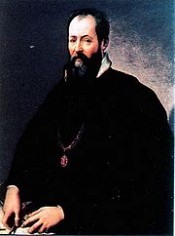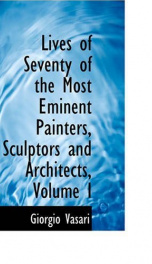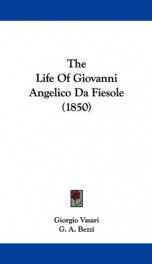Vasari Giorgio

Giorgio Vasari (30 July 1511 – 27 June 1574) was an Italian painter and architect, who is today famous for his biographies of Italian artists, considered the ideological foundation of art-historical writing. Vasari was born in Arezzo, Tuscany. Recommended at an early age by his cousin Luca Signorelli, he became a pupil of Guglielmo da Marsiglia, a skilful painter of stained glass. Sent to Florence at the age of sixteen by Cardinal Silvio Passerini, he joined the circle of Andrea del Sarto and his pupils Rosso Fiorentino and Jacopo Pontormo where his humanist education was encouraged. He was befriended by Michelangelo whose painting style would influence his own. In 1529 he visited Rome and studied the works of Raphael and others of the Roman High Renaissance. Vasari's own Mannerist paintings were more admired in his lifetime than afterwards. He was consistently employed by patrons in the Medici family in Florence and Rome, and he worked in Naples, Arezzo and other places. Many of his pictures still exist, the most important being the wall and ceiling paintings in the great Sala di Cosimo I of the Palazzo Vecchio in Florence, where he and his assistants were at work from 1555, and his uncompleted frescoes inside the vast cupola of the Duomo, completed by Federico Zuccari and with the help of Giovanni Balducci. He also helped organize the decoration of the Studiolo, now reassembled in the Palazzo Vecchio. As an architect, Vasari was perhaps more successful than as a painter. His loggia of the Palazzo degli Uffizi by the Arno opens up the vista at the far end of its long narrow courtyard, a unique piece of urban planning that functions as a public piazza, and which, if considered as a short street, is the unique Renaissance street with a unified architectural treatment. The view of the Loggia from the Arno reveals that, with the Vasari Corridor, it is one of very few structures that line the river which are open to the river itself and appear to embrace the riverside environment. In Florence, Vasari also built the long passage, now called Vasari Corridor, which connects the Uffizi with the Palazzo Pitti on the other side of the river. The enclosed corridor passes alongside the River Arno on an arcade, crosses the Ponte Vecchio and winds around the exterior of several buildings. Vasari also renovated the fine medieval churches of Santa Maria Novella and Santa Croce, from both of which he removed the original rood screen and loft, and remodelled the retro-choir in the Mannerist taste of his time. In Rome, Vasari worked with Giacomo Barozzi da Vignola and Bartolomeo Ammanati at Pope Julius III's Villa Giulia. Vasari enjoyed high repute during his lifetime and amassed a considerable fortune. In 1547, he built himself a fine house in Arezzo (now a museum honouring him), and laboured to decorate its walls and vaults with paintings. He was elected to the municipal council or priori of his native town, and finally rose to the supreme office of gonfaloniere. In 1563, he helped found the Florence Accademia e Compagnia delle Arti del Disegno, with the Grand Duke and Michelangelo as capi of the institution and 36 artists chosen as members. Vasari died at Florence on 27 June 1574. As the first Italian art historian, he initiated the genre of an encyclopedia of artistic biographies that continues today. Vasari coined the term "Renaissance" (rinascita) in print, though an awareness of the ongoing "rebirth" in the arts had been in the air from the time of Alberti. Vasari's Le Vite delle più eccellenti pittori, scultori, ed architettori (Lives of the Most Excellent Painters, Sculptors, and Architects) — dedicated to Grand Duke Cosimo I de' Medici — was first published in 1550. It included a valuable treatise on the technical methods employed in the arts. It was partly rewritten and enlarged in 1568, with the addition of woodcut portraits of artists (some conjectural). The work has a consistent and notorious bias in favour of Florentines and tends to attribute to them all the developments in Renaissance art — for example, the invention of engraving. Venetian art in particular (along with arts from other parts of Europe), is systematically ignored in the first edition. Between the first and second editions, Vasari visited Venice and while the second edition gave more attention to Venetian art (finally including Titian) it did so without achieving a neutral point of view. Vasari's biographies are interspersed with amusing gossip. Many of his anecdotes have the ring of truth, while others are inventions or generic fictions, such as the tale of young Giotto painting a fly on the surface of a painting by Cimabue that the older master repeatedly tried to brush away, a genre tale that echoes anecdotes told of the Greek painter Apelles. With a few exceptions, however, Vasari's aesthetic judgement was acute and unbiased. He did not research archives for exact dates, as modern art historians do, and naturally his biographies are most dependable for the painters of his own generation and those of the immediate past. Modern criticism — with new materials opened up by research — has corrected many of his traditional dates and attributions. The work remains a classic, though it must be supplemented by modern critical research. Vasari includes a sketch of his own biography at the end of his Lives, and adds further details about himself and his family in his lives of Lazzaro Vasari and Francesco Salviati. According to the historian Richard Goldthwaite, Vasari was one of the earliest authors to use the word "competition" (or "concorrenza") in Italian in its economic sense. He used it repeatedly, but perhaps most notably while explaining the reasons for Florentine preeminence, in the introduction to his life of Pietro Perugino. In Vasari's view, Florentine artists excelled because they were hungry, and they were hungry because their fierce competition for commissions each with the others kept them hungry. Competition, he said, is "one of the nourishments that maintain them." This article incorporates text from the Encyclopædia Britannica, Eleventh Edition, a publication now in the public domain. The Uffizi colonnade and loggia The Uffizi Loggia seen from the Arno River The Loggia of Vasari in Arezzo The painting of the interior of the dome of Florence Cathedral was commenced by Vasari Copies of Vasari’s Lives of the Artists online:
do you like this author?
What readers are saying
What do you think? Write your own comment on this book!
write a commentWhat readers are saying
What do you think? Write your own comment on this author!
write a commentBook list

Lives of the most Eminent Painters Sculptors and ArchitectsVol 10 (of 10) Bronzino to Vasari,& General Index.
Series:
Unknown
Year:
Unknown
Raiting:
5/5
Show more
add to favoritesadd In favorites

Lives of the Most Eminent Painters,Sculptors and Architects
Vol. 09 (of 10) Michelagnolo to the Flemings
Series:
Unknown
Year:
Unknown
Raiting:
4/5
Show more
add to favoritesadd In favorites

Lives of the most Eminent Painters Sculptors and ArchitectsVol 08 (of 10) Bastiano to Taddeo Zucchero
Series:
Unknown
Year:
Unknown
Raiting:
4.5/5
Show more
add to favoritesadd In favorites
Book list

Lives of the most Eminent Painters Sculptors and ArchitectsVol 10 (of 10) Bronzino to Vasari,& General Index.
Series:
Unknown
Year:
Unknown
Raiting:
5/5
Show more
add to favoritesadd In favorites

Lives of the Most Eminent Painters,Sculptors and Architects
Vol. 09 (of 10) Michelagnolo to the Flemings
Series:
Unknown
Year:
Unknown
Raiting:
4/5
Show more
add to favoritesadd In favorites

Lives of the most Eminent Painters Sculptors and ArchitectsVol 08 (of 10) Bastiano to Taddeo Zucchero
Series:
Unknown
Year:
Unknown
Raiting:
4.5/5
Show more
add to favoritesadd In favorites

Lives of the most Eminent Painters Sculptors and ArchitectsVol 07 (of 10) Tribolo to Il Sodoma
Series:
Unknown
Year:
Unknown
Raiting:
3.5/5
Show more
add to favoritesadd In favorites

Lives of the most Eminent Painters Sculptors and ArchitectsVol. 06 (of 10) Fra Giocondo to Niccolo Soggi
Series:
Unknown
Year:
Unknown
Raiting:
3.5/5
Show more
add to favoritesadd In favorites

Lives of the Most Eminent Painters Sculptors and ArchitectsVol. 05 (of 10) Andrea da Fiesole to Lorenzo Lotto
Series:
Unknown
Year:
Unknown
Raiting:
4.5/5
Show more
add to favoritesadd In favorites

Lives of the Most Eminent Painters Sculptors and ArchitectsVol. 04 (of 10),Filippino Lippi to Domenico Puligo
Series:
Unknown
Year:
Unknown
Raiting:
3/5
Show more
add to favoritesadd In favorites

Lives of the Most Eminent Painters Sculptors and Architects
Vol. 03 (of 10),Filarete and Simone to Mantegna
Series:
Unknown
Year:
Unknown
Raiting:
4/5
Show more
add to favoritesadd In favorites

Lives of the Most Eminent Painters Sculptors and Architects
Vol. 02 (of 10),Berna to Michelozzo Michelozzi
Series:
Unknown
Year:
Unknown
Raiting:
5/5
Show more
add to favoritesadd In favorites

Lives of the Most Eminent Painters Sculptors and Architects
Vol. 01 (of 10),Cimabue to Agnolo Gaddi
Series:
Unknown
Year:
Unknown
Raiting:
3/5
Show more
add to favoritesadd In favorites

The Lives of the Painters,Sculptors & Architects,Volume 1 (of 8)
Series:
Unknown
Year:
Unknown
Raiting:
2.5/5
Show more
add to favoritesadd In favorites

lives of seventy of the most eminent painters sculptors and architects volume
Series:
Unknown
Year:
Unknown
Raiting:
4.5/5
Show more
add to favoritesadd In favorites

The Lives of the Painters, Sculptors & Architects, Volume 1 (of 8)
Series:
Unknown
Year:
Unknown
Raiting:
4.5/5
This book was converted from its physical edition to the digital format by a community of volunteers. You may find it for free on the web. Purchase of the Kindle edition includes wireless delivery.
Show more
add to favoritesadd In favorites

Lives of the Most Eminent Painters Sculptors and Architects
Series:
Unknown
Year:
Unknown
Raiting:
3/5
Show more
add to favoritesadd In favorites
What readers are saying
What do you think? Write your own comment on this author!
write a commentif you like Vasari Giorgio try:
readers also enjoyed
What readers are saying
What do you think? Write your own comment on this author!
write a commentGenre
if you like Vasari Giorgio try:
readers also enjoyed
Do you want to exchange books? It’s EASY!
Get registered and find other users who want to give their favourite books to good hands!


